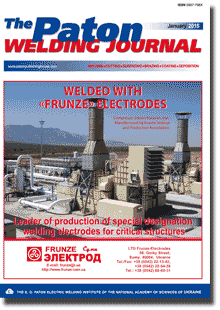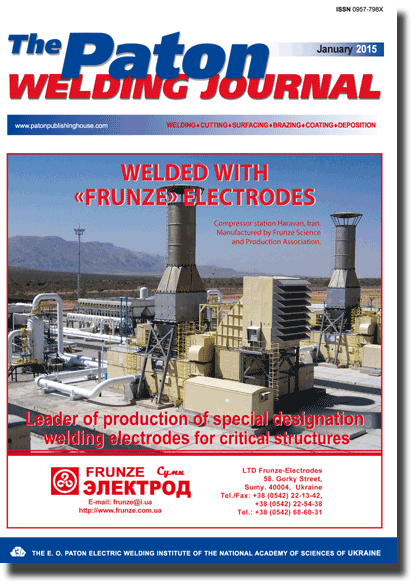| 2015 №01 (03) |
DOI of Article 10.15407/tpwj2015.01.04 |
2015 №01 (05) |

The Paton Welding Journal, 2015, #1, 24-28 pages
PREDICTION OF THERMODYNAMIC PROPERTIES OF Al2O3-SiO2 SYSTEM MELTS
I.A. Goncharov1, V.I. Galinich1, D.D. Mishchenko1 And V.S. Sudavtsova2
1E.O. Paton Electric Welding Institute, NASU. 11 Bozhenko Str., 03680, Kiev, Ukraine. E-mail: office@paton.kiev.ua
2I.M. Frantsevich Institute of Problems of Materials Science, NASU. 3 Krzhizhanovsky Str., 03680, Kiev, Ukraine
Abstract
Aluminium and silicon oxides are included into the composition of fluxes for welding, electroslag remelting and metallurgical slags. Knowledge of thermodynamic properties of aluminium oxide-silicon oxide system mixtures will allow evaluation of the nature of their interaction in the melt that will provide an insight into the metallurgical properties of the respective materials for welding and related technologies developed on their base. Analysis of published data on phase equilibria of constitutional diagrams of aluminium oxide-silicon oxide system and thermodynamic properties of this system was performed. It is established that the constitutional diagram data are correct, and experimental values of activities of these melt components are characterized by large scatter. The coordinates of liquidus line of the constitutional diagram of aluminium oxide-silicon oxide system were used to calculate the thermodynamic activities of aluminium oxide at its concentration in the range of 0.7-1.0. It is established that they start manifesting small negative deviations from ideal solutions in the eutectic melt (0.74). Integration of Gibbs-Dugem equation was performed to assess the activities of silicon oxide. It was determined that they demonstrate slight negative deviations from ideal solutions. It is shown that the influence of aluminium oxide-silicon oxide system melts on the nature of interaction in complex multicomponent solutions can be significant. It is found that addition of thermodynamically stable chemical compounds (for instance, sillimanite) to multicomponent slag melts leads to lowering of their oxidizing ability. Replacement of quartz sand and alumina by disthen-sillimanite concentrate in agglomerated flux charge leads to lowering of thermodynamic activity of oxygen in the slag melt, slows down running of silicon-reduction process and reduces manganese losses in welding. 25 Ref., 6 Figures.
Keywords: aluminium and silicon oxides, constitutional diagrams, thermodynamic activity of components, slag melts, fluxes for welding and electroslag remelting
Received: 30.10.14
Published: 28.02.15
References
1. Zajtsev, A.I., Mogutnov, B.M., Shakhpazov, E.Kh. (2008) Physical chemistry of metallurgical slags. Moscow: Interkontakt Nauka.
2. Shepherd, E.S., Rankin, G.A., Wright, F.E. (1909) The binary systems of alumina with silica, lime and magnesia. Am. J. Sci., 28, 293-298.
3. Bowen, N.L., Greig, J.W. (1924) The system alumina-silica. J. Am. Ceram. Soc., 7, 238-254.
4. Bowen, N.L., Greig, J.W., Zies, E.G. (1924) Mullite, a silicate of alumina. J. of the WashingtonAcademy of Sci., 14, 183-191.
5. Chaudhuri, S.P. (1987) Melting/decomposition of mullite: Incongruent or congruent? Pt I: Phase equilibria of the system aluma-silica. Ceram. Int., 13(3), 167-175. https://doi.org/10.1016/0272-8842(87)90027-7
6. Chaudhuri, S.P. (1987) Melting/decomposition of mullite: Incongruent or congruent? Pt II: Responsible factors for dual nature of mullite. Ibid., 13(3), 177-181. https://doi.org/10.1016/0272-8842(87)90028-9
7. Gao, Z. (1981) Review of studies and controversy on the phase diagram of the alumina-silica system. Ibid., 9(2), 197-217.
8. Mueller-Hesse, H. (1963) The development of investigations and present-day knowledge of the system Al2O3-SiO2. Ber. Deut. Keram. Ges., 40(5), 281-285.
9. Pask, J.A. (1990) Critical review of phase equilibria in the alumina-silica system. Ceram. Transact., 6, 1-13.
10. Roy, R. (1990) The alumina-silica phase diagram: Metastability and order-disorder. Ibid., 45-50, 1-132.
11. Jantzen, C.M., Schwahn, D., Schelten, J. et al. (1981) The silica alumina system. Pt1: Later stage spinodal decomposition and metastable immiscibility. Phys. Chem. Glasses, 22(5), 122-137.
12. Shornikov, S.I., Archakov, I.Yu. (2000) Mass-spectrometric study of processes of evaporation and phase equilibria in Al2O3-SiO2 system. Zhurnal Phys. Khimii, 74(5), 775-782.
13. Aksay, I.A., Pask, J.A. (1975) Stable and metastable equilibriums in the system silica-alumina. J. Am. Ceram. Soc., 58(11/12), 507-512. https://doi.org/10.1111/j.1151-2916.1975.tb18770.x
14. Staronka, A., Pham, H., Rolin, M. (1968) Cooling curve study on the silica-alumina system. Revue Int. des Hautes Temp. et des Refractaires, 5(2), 111-115.
15. Aramaki, S., Roy, R. (1962) Revised phase diagram for the system Al2O3-SiO2. Ibid., 45, 229-242.
16. Zajtsev, A.I., Litvina, A.D., Mogutnov, B.M. (1995) Thermodynamical properties of mullite 3Al2O3р2SiO2. Neorgan. Materialy, 31(6), 768-772.
17. Shornikov, S.I., Stolyarova, V.L., Shultz, M.M. (1994) High temperature mass spectrometric study of 3Al2O3р2SiO2. Rapid Commun. Mass Spectrom., 8(6), 478-480. https://doi.org/10.1002/rcm.1290080610
18. Dhima, A., Stafa, B., Allibert, M. (1986) Activity measurements in steelmaking-related oxide melts by differential mass spectrometry. High Temperature Sci., 21(3), 143-159.
19. Shornikov, S.I., Archakov, I.Yu., Chemekova, T.Yu. (2000) Mass spectrometric study of thermodynamical properties of Al2O3-SiO2 melts. Zhurnal Phys. Khimii, 74(5), 783-788.
20. Bjorkvall, J., Stolyarova, V.L. (2001) A mass spectrometric study of Al2O3-SiO2 melts using a Knudsen cell. Rapid Commun. Mass Spectrom., 15(10), 836-842. https://doi.org/10.1002/rcm.251
21. Bondar, V.V., Lopatin, S.I., Stolyarova, V.L. (2005) Thermodynamical properties of Al2O3-SiO2 system at high temperatures. Neorgan. Materialy, 41(4), 362-369. https://doi.org/10.1007/s10789-005-0138-5
22. Mao, H., Seleby, M., Sundman, B. (2005) Phase equilibria and thermodynamics in the Al2O3-SiO2 system modeling of mullite and liquid. J. Am. Ceram. Soc., 88(9), 2544-2551. https://doi.org/10.1111/j.1551-2916.2005.00440.x
23. Jak, E., Hayes, P.C., Pelton, A.D. et al. (2009) Thermodynamic modeling of the Al2O3-CaO-FeO-Fe2O3-PbO-SiO2-ZnO system with addition of K and Na with metallurgical applications. In: Proc. of 8th Int. Conf. on Molten Slags, Fluxes and Salts, 473-490. Santiago: Geramin.
24. Sudavtsova, V.S., Makara, V.A., Kudin, V.G. (2005) Thermodynamics of metallurgical and welding melts. Pt3: Alloys based on nickel and tin, methods of modeling and prediction of thermodynamic properties. Kiev: Logos.
25. Goncharov, I.A., Galinich, V.I., Mishchenko, D.D. et al. (2014) Prediction of thermodynamic properties of melts of Al2O3-SiO2 system. The Paton Welding J., 4, 26-29.
Suggested Citation
I.A. Goncharov, V.I. Galinich, D.D. Mishchenko And V.S. Sudavtsova (2015) Prediction of thermodynamic properties of Al2O3-SiO2 system melts. The Paton Welding J., 01, 24-28.The cost of subscription/purchase order journals or individual articles
| Journal/Currency | Annual Set | 1 issue printed |
1 issue |
one article |
| TPWJ/USD | 384 $ | 32 $ | 26 $ | 13 $ |
| TPWJ/EUR | 348 € | 29 € | 24 € | 12 € |
| TPWJ/UAH | 7200 UAH | 600 UAH | 600 UAH | 280 UAH |
| AS/UAH | 1800 UAH | 300 UAH | 300 UAH | 150 UAH |
| AS/USD | 192 $ | 32 $ | 26 $ | 13 $ |
| AS/EUR | 180 € | 30 € | 25 € | 12 € |
| SEM/UAH | 1200 UAH | 300 UAH | 300 UAH | 150 UAH |
| SEM/USD | 128 $ | 32 $ | 26 $ | 13 $ |
| SEM/EUR | 120 € | 30 € | 25 € | 12 € |
| TDNK/UAH | 1200 UAH | 300 UAH | 300 UAH | 150 UAH |
| TDNK/USD | 128 $ | 32 $ | 26 $ | 13 $ |
| TDNK/EUR | 120 € | 30 € | 25 € | 15 € |
AS = «Automatic Welding» - 6 issues per year;
TPWJ = «PATON WELDING JOURNAL» - 12 issues per year;
SEM = «Electrometallurgy Today» - 4 issues per year;
TDNK = «Technical Diagnostics and Non-Destructive Testing» - 4 issues per year.


